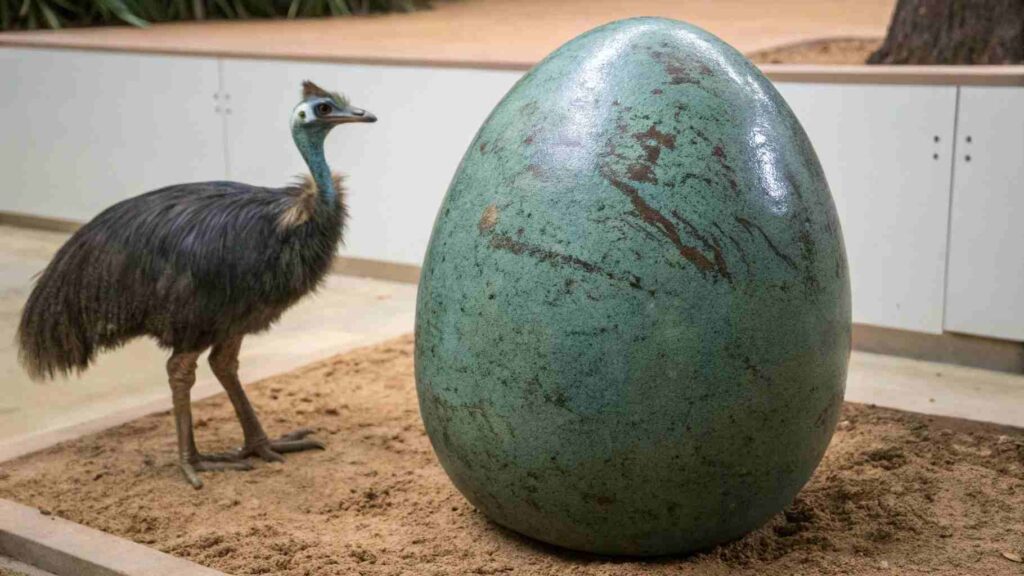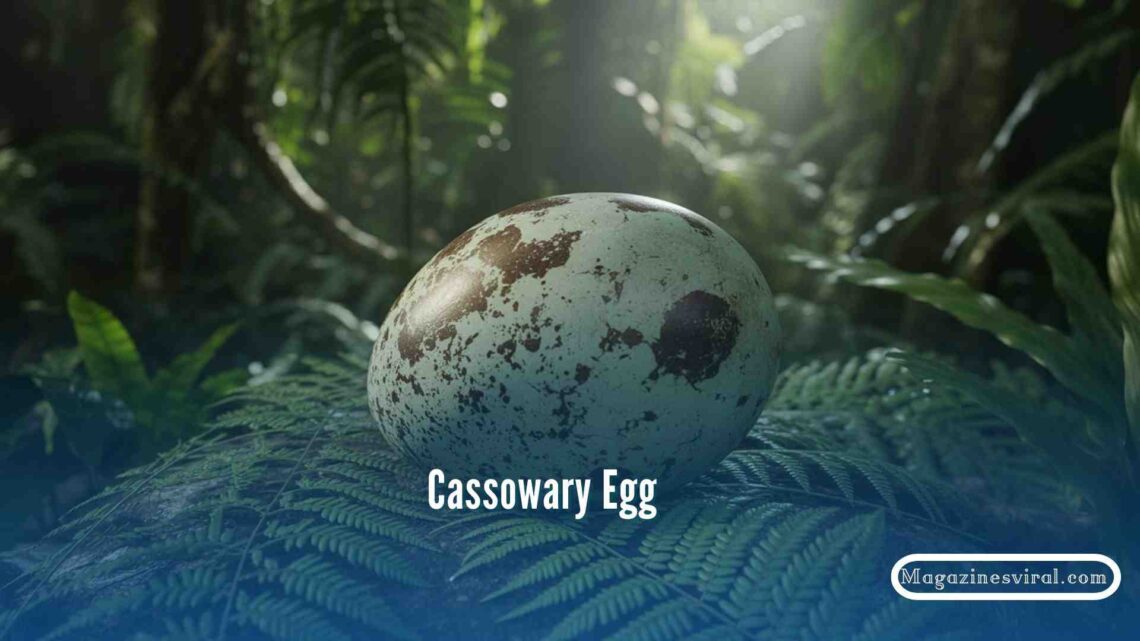A cassowary egg is a large bright green egg laid by the rare cassowary bird found in Australia and New Guinea. Known for its size and unique color it plays a vital role in rainforest life.
Stay tuned with us as we dive deeper into the wild world of the Cassowary Egg — its secrets, colors and amazing role in nature. You won’t want to miss what’s coming next!
What Is a Cassowary?
Before we go deep into the egg.Let’s take a moment to understand the creature behind it.
Cassowaries are large flightless birds native to tropical rainforests of Northern Australia, Papua New Guinea and nearby islands. They are members of the ratite family, which includes emus, ostriches and kiwis. There are three recognized species:
- Southern Cassowary (Casuarius casuarius) – the most common and largest.
- Northern Cassowary (Casuarius unappendiculatus)
- Dwarf Cassowary (Casuarius bennetti)
Known for their helmet-like casque, powerful legs and dagger-like claws, cassowaries are often dubbed the most dangerous birds in the world.
Cassowary Egg Appearance: A Living Gem of the Forest

Color and Texture
The cassowary egg is most recognizable for its astonishing deep green or blue-green shell. This unique coloration helps it blend in with the rainforest floor, protecting it from predators.
- Color: Ranges from jade green to turquoise.
- Texture: Coarse, rough surface with a gritty or sandpaper-like feel.
This exotic color is rare in the avian world and adds to the bird’s mystique.
Size and Weight
| Feature | Cassowary Egg | Chicken Egg | Ostrich Egg |
| Length | 5.5–6 inches (14–15 cm) | 2.3 inches (6 cm) | 6 inches (15 cm) |
| Weight | 3.3–3.5 lbs (1.5–1.6 kg) | ~2 oz (57 g) | ~3 lbs (1.4 kg) |
| Shell Color | Green/Blue | White/Brown | Cream/Tan |
| Texture | Rough and grainy | Smooth | Smooth |
Cassowary eggs are second in weight only to ostrich eggs but due to their darker color they stand out visually even more.
The Science Behind the Egg: Evolution and Adaptation
A Prehistoric Link
Cassowaries are considered one of the closest living relatives to the Velociraptor and other theropod dinosaurs. Their eggs reflect this ancient lineage.
- The green pigmentation is caused by biliverdin, a bile pigment also found in some fish and amphibians.
- The thick shell protects the embryo in unstable rainforest conditions such as flooding or predation.
Why the Color?
The blue-green coloration:
- Camouflages the eggs against moss, leaves and soil.
- May signal health and fertility of the female to potential mates (though this is still being studied).
Cassowary Reproduction and Egg Laying Process
Mating Rituals
Cassowaries are mostly solitary but come together during the breeding season typically between June and October.
- Males perform deep rumbling calls and low dances to attract females.
- After mating the female lays 3 to 5 eggs in a shallow nest made of leaves and grass.
Male Parental Role
In a fascinating reversal of traditional roles:
- The male incubates the eggs for about 50 days.
- He does not eat or drink much during this time.
- After hatching, he cares for the chicks for 9–12 months teaching them how to forage and protecting them fiercely.
This male-dominated parenting strategy is rare among birds and offers a unique look into cassowary behavior.
Ecological Importance of Cassowary Eggs and Chicks
Cassowaries are key seed dispersers in their ecosystems. They eat a wide variety of fruits and excrete the seeds far from the parent plant helping forests regenerate.
- Consume over 150 plant species.
- Swallow entire fruits including some the size of tennis balls.
- Travel up to 5 miles per day spreading seeds as they go.
Without cassowaries many tree species would struggle to reproduce — making every egg incredibly valuable.
Are Cassowary Eggs Endangered?
Conservation Status
The Southern Cassowary is listed as Vulnerable on the IUCN Red List. Threats include:
- Habitat destruction
- Vehicle collisions
- Dog attacks
- Illegal egg harvesting
Protected by Law
In Australia and Papua New Guinea, cassowaries and their eggs are legally protected. It is illegal to collect, sell or harm cassowary eggs in the wild.
Cultural Significance of Cassowary Eggs
Indigenous Beliefs
In Indigenous Australian and New Guinean cultures cassowaries are:
- Spiritual figures associated with power and protection.
- Symbols of fertility and strength.
- Often depicted in art, dance and mythology.
The egg as a life-giving object holds symbolic importance and is sometimes used in traditional rituals (though not commonly today due to legal protections).
Can You Hatch a Cassowary Egg in Captivity?
Yes, but it is extremely challenging.
Captive Breeding
- Wildlife parks and zoos use artificial incubation when the male cannot tend to the eggs.
- Conditions must mimic natural rainforest settings: humidity, temperature, rotation and timing are crucial.
Challenges
- Cassowaries imprint on the first thing they see — improper rearing can lead to behavioral issues.
- Chicks require specialized diets and large secure enclosures.
Many facilities prefer to let the male do the work as nature intended.
Fun Facts About Cassowary Eggs
- Color change: The egg darkens slightly during incubation.
- Sound barrier: Cassowary chicks begin vocalizing while still inside the egg — possibly to bond with their dad.
- Extremely durable: The shell is thick enough to require real effort from the chick to crack it open.
- Replicas exist: Museums and zoos often use high-quality replicas for display due to the egg’s rarity.
Can You Own a Cassowary Egg?
The Short Answer: No.
Even unhatched or nonviable cassowary eggs are protected under:
- CITES (Convention on International Trade in Endangered Species)
- Australian Environment Protection and Biodiversity Conservation Act
Violating these laws can result in fines or imprisonment.Replicas or legal displays (like in a museum) are your best bet if you’re interested in collecting.
Are Cassowary Eggs Sold Anywhere?
Legitimate cassowary eggs are not for sale to the public. If you find one online it is likely:
- A replica made of resin or plaster.
- Illegal in which case you should report the seller.
Be wary of scams or sellers claiming to have “authentic” cassowary eggs.
FAQ’s
1. Can you eat a cassowary egg?
Technically, yes — but you should not. Cassowary eggs are protected by law and eating or taking one is illegal in many places.
2. Why are cassowary eggs green?
Cassowary eggs are green to blend in with the forest floor helping to hide them from predators like snakes and other animals.
3. Was Cassowary a dinosaur?
Not exactly — but cassowaries are very closely related to dinosaurs. In fact, they look and act a lot like small feathered dinosaurs!
4. How long does a cassowary egg take to hatch?
It takes about 50 days for a cassowary egg to hatch. During this time the father bird keeps the egg warm and safe.
5. Why are cassowaries so special?
Cassowaries are special because they are ancient-looking birds, cannot fly and help rainforests grow by spreading seeds. They are also one of the few birds where the dad raises the chicks.
6. Do any U.S. zoos have cassowaries?
Yes! Some big zoos in the U.S. like the San Diego Zoo and Bronx Zoo have cassowaries that you can visit and learn about.
Conclusion:
Cassowary eggs are amazing and full of mystery just like the bird itself. From their green color to the father’s care every detail is unique. Learning about cassowaries helps us understand nature better. Let’s protect these rare birds and their eggs for future generations to enjoy and learn from.



